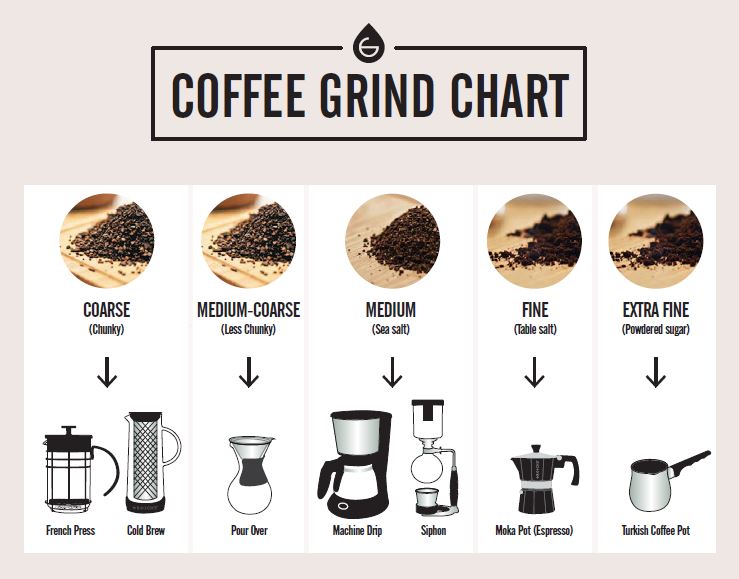Coffee Grind Size Chart: a Guide for all Brewing Methods
 coffee grind size chart - If you notice that your coffee is coming out too thin for your taste, try out a finer grind. If you notice that your espresso is coming out watery, use a finer grind. If you notice that you have to push hard, then you likely are using too fine of a grind. That said, bunn cw series we recommend starting with a medium fine grind (somewhere between an espresso grind and pour over grind).
coffee grind size chart - If you notice that your coffee is coming out too thin for your taste, try out a finer grind. If you notice that your espresso is coming out watery, use a finer grind. If you notice that you have to push hard, then you likely are using too fine of a grind. That said, bunn cw series we recommend starting with a medium fine grind (somewhere between an espresso grind and pour over grind).
With a medium grind, you should try to get a texture that feels like regular beach sand. Medium fine grounds look like fine sand and lie exactly between Extreme coarse and Extreme Fine. With a medium coarse grind, you should shoot for a texture that's similar to large grains of sand. What this leaves us with is a drink that tastes sour or sharp on the tongue, that lacks a certain well-rounded sense of sweetness that's pleasant to taste rather than makes you pucker your lips and back away from the cup.
Espresso is a flexible brewing technique that can be used to make a variety of coffee beverages, but it also tastes fantastic on its own. For now, how to make percolated coffee let's focus on the right grind size for your brewing method. The French Press is a tough method to get right. The same thing goes for a French press. It's the best grind size for French Press, as well as some types of percolators.
If you want to drink the best tasting coffee, this coffee grind chart is what you first need to know. Everything you need to know about the how to grind coffee for your particular brewing method will be down below. It doesn't matter how great your coffee maker or espresso machine is or how well you know the brewing techniques and steps.
It is just a matter of preference or convenience, how much budget you want to spend on a grinder, and whether or not you are willing to spend time and energy in grinding coffee beans. The reason behind this is: grinding exposes the coffee grounds to oxygen. You will get inconsistent grounds if you use a blender and inconsistent grounds result in an unbalanced and flavorless cup of coffee.
If you use Robusta beans, the coffee may be over extracted and far too caffeinated. The Kalita Wave calls for a medium fine grind, although you may need to tinker with this a bit to get the desired results. To do this, you'll need a fine grind. A coarser grind, on the other hand, has very little surface area exposed and this creates a need for more contact time with water.
On the other hand, it's equally important to keep in mind that if you don't grind coffee beans enough, they can turn way too watery. On the other hand, if you face little resistance when you press, you should opt for a finer grind. This gives you enough resistance when you press, and it helps you extract all of the flavors of the coffee without too much bitterness. In most cases, you should stick to a fine grind when using a moka pot, as this will help increase pressure and extract more flavor and caffeine.
If you want to switch it up and go for a fine grind to make espresso to put into your iced latte, you can do that too. You'll also want to grind coarse when using a percolator. The type of grind you'll need for drip coffee will depend on the type of drip pot that you have. Keep in mind that not every moka pot is the same, so you may have to experiment a bit to find the right grind size.
You may use a sieve, paper towel, or a crude sifter to achieve a consistent grind. Although moka pots are not a true substitute for an espresso machine, they do use a similar grind size. For example, what happens if the TDS and PE are not within the ideal region? Just make sure you are using Arabica beans. With a Chemex, you'll want a medium to medium coarse grind to make the perfect cup.
When done properly, the method gives you a smooth, rounded cup of coffee. The coffee grind chart below will help you brew coffee depending on the method you choose. But the best way to do this varies depending on the brewing method, and requires different grind sizes. What grind is best for coffee maker? This is the best grind to use with a Chemex or Clever Dripper. The Kalita Wave drains better than most cone shaped pour over filters, so you can use a finer grind without too much risk of bitter, over extracted coffee.
With cone shaped drip pots, you can still use a medium grind, although you might want to move to a medium fine grind. But if you're going for a short brew, use a fine grind. The texture of fine grounds is like powdered sugar or a little finer than table salt. From the name, bunn professional coffee maker you can tell the texture of this grind. It can take a while to really get the V60 down pat.


Comments
Post a Comment